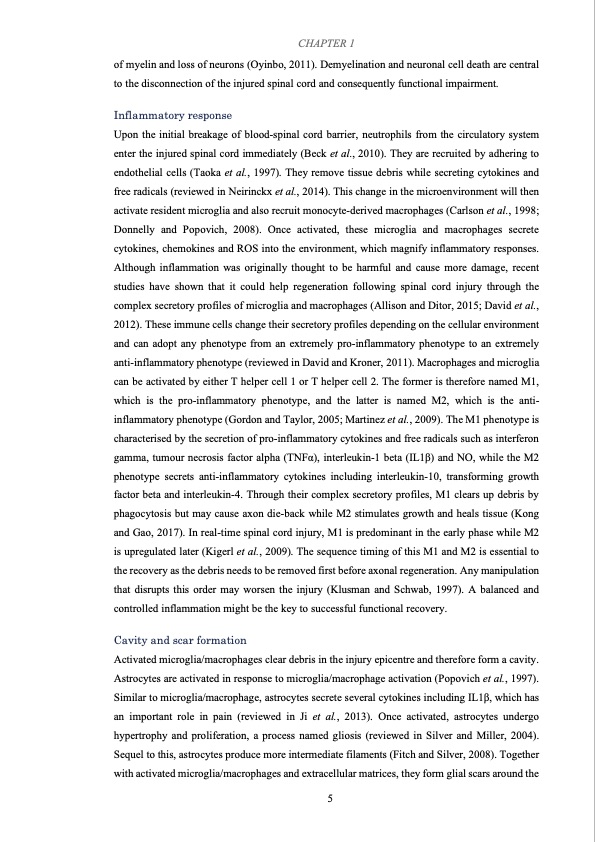
PDF Publication Title:
Text from PDF Page: 019
CHAPTER 1 of myelin and loss of neurons (Oyinbo, 2011). Demyelination and neuronal cell death are central to the disconnection of the injured spinal cord and consequently functional impairment. Inflammatory response Upon the initial breakage of blood-spinal cord barrier, neutrophils from the circulatory system enter the injured spinal cord immediately (Beck et al., 2010). They are recruited by adhering to endothelial cells (Taoka et al., 1997). They remove tissue debris while secreting cytokines and free radicals (reviewed in Neirinckx et al., 2014). This change in the microenvironment will then activate resident microglia and also recruit monocyte-derived macrophages (Carlson et al., 1998; Donnelly and Popovich, 2008). Once activated, these microglia and macrophages secrete cytokines, chemokines and ROS into the environment, which magnify inflammatory responses. Although inflammation was originally thought to be harmful and cause more damage, recent studies have shown that it could help regeneration following spinal cord injury through the complex secretory profiles of microglia and macrophages (Allison and Ditor, 2015; David et al., 2012). These immune cells change their secretory profiles depending on the cellular environment and can adopt any phenotype from an extremely pro-inflammatory phenotype to an extremely anti-inflammatory phenotype (reviewed in David and Kroner, 2011). Macrophages and microglia can be activated by either T helper cell 1 or T helper cell 2. The former is therefore named M1, which is the pro-inflammatory phenotype, and the latter is named M2, which is the anti- inflammatory phenotype (Gordon and Taylor, 2005; Martinez et al., 2009). The M1 phenotype is characterised by the secretion of pro-inflammatory cytokines and free radicals such as interferon gamma, tumour necrosis factor alpha (TNFα), interleukin-1 beta (IL1β) and NO, while the M2 phenotype secrets anti-inflammatory cytokines including interleukin-10, transforming growth factor beta and interleukin-4. Through their complex secretory profiles, M1 clears up debris by phagocytosis but may cause axon die-back while M2 stimulates growth and heals tissue (Kong and Gao, 2017). In real-time spinal cord injury, M1 is predominant in the early phase while M2 is upregulated later (Kigerl et al., 2009). The sequence timing of this M1 and M2 is essential to the recovery as the debris needs to be removed first before axonal regeneration. Any manipulation that disrupts this order may worsen the injury (Klusman and Schwab, 1997). A balanced and controlled inflammation might be the key to successful functional recovery. Cavity and scar formation Activated microglia/macrophages clear debris in the injury epicentre and therefore form a cavity. Astrocytes are activated in response to microglia/macrophage activation (Popovich et al., 1997). Similar to microglia/macrophage, astrocytes secrete several cytokines including IL1β, which has an important role in pain (reviewed in Ji et al., 2013). Once activated, astrocytes undergo hypertrophy and proliferation, a process named gliosis (reviewed in Silver and Miller, 2004). Sequel to this, astrocytes produce more intermediate filaments (Fitch and Silver, 2008). Together with activated microglia/macrophages and extracellular matrices, they form glial scars around the 5PDF Image | Effects of Red Light Treatment on Spinal Cord Injury

PDF Search Title:
Effects of Red Light Treatment on Spinal Cord InjuryOriginal File Name Searched:
Thesis_Di Hu_final.pdfDIY PDF Search: Google It | Yahoo | Bing
Cruise Ship Reviews | Luxury Resort | Jet | Yacht | and Travel Tech More Info
Cruising Review Topics and Articles More Info
Software based on Filemaker for the travel industry More Info
The Burgenstock Resort: Reviews on CruisingReview website... More Info
Resort Reviews: World Class resorts... More Info
The Riffelalp Resort: Reviews on CruisingReview website... More Info
| CONTACT TEL: 608-238-6001 Email: greg@cruisingreview.com | RSS | AMP |